This 8-Minute Morning Bodyweight Routine Builds More Strength Than 30 Minutes at the Gym After 50
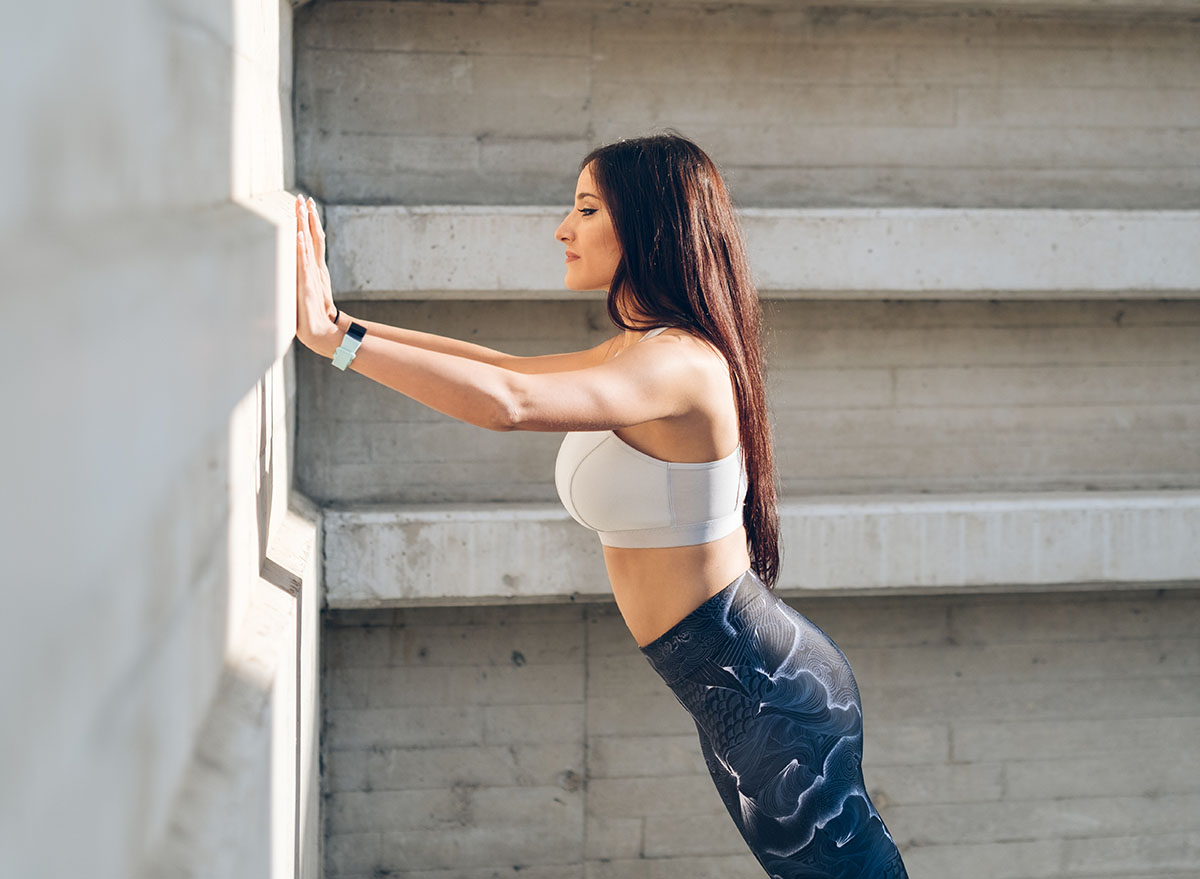
Two of the biggest hurdles people over 50 face when starting a strength training program are time and intimidation: either you don’t have enough hours in the day, or the gym environment feels overwhelming. Here’s what most people don’t realize: strength training doesn’t need to take a huge amount of time, and it definitely doesn’t require expensive equipment or a gym membership. The morning workout below takes just 8 minutes, makes a great start to your day, and can be more effective than spending 30 minutes at the gym. Keep reading to discover how this simple routine can transform your strength and make everyday activities feel effortless again.
The Biggest Mistakes You’re Making When Trying to Build Strength
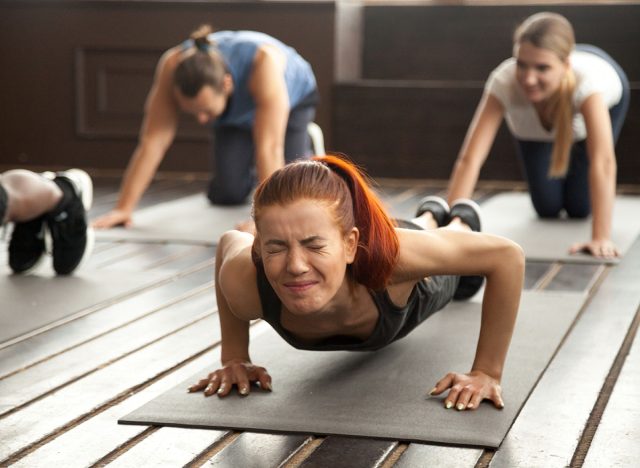
At TRAINFITNESS, one of our most popular courses is on working with older adults, so it’s something I’ve got a huge amount of experience with.
The one I see most regularly is people thinking that they can only get results if they are lifting heavy weights. I’ve worked with people over 50 for three decades, and I’ve seen way too many individuals walk into gyms, grab something that’s way too heavy, and hurt themselves within their first few sessions. Once you get to fifty, your joints have decades of wear and tear; they don’t need maximum loads, they need consistent and controlled movement that builds strength without beating up your body.
The next one is trying to do too much too soon. Our bodies need time to adapt. The connective tissues strengthen much more slowly than our muscles do. You might feel great during the workout, but a couple of days later, you’re so sore you can hardly move – completely killing any momentum.
The third mistake is terrible form. People rush through movements, use momentum instead of muscle control, and compensate with the wrong body parts. Bad form doesn’t just limit results; it creates injuries that take weeks or months to recover from.
RELATED: If You Can Hold These 4 Bodyweight Positions After 50, You’re Fitter Than Most Gym-Goers
Why Your 8-Minute Routine Beats 30 Minutes at the Gym

It’s about efficiency and intensity within your current capacity. When you walk into a gym, most of those 30 minutes get wasted. You might only get 12-15 minutes of actual work. An 8-minute bodyweight routine is 8 minutes of pure movement – no transitions, no setup, no equipment faffing about.
Bodyweight exercises force you to control your entire body as one unit. When you do a gym machine chest press, you’re isolating your chest muscles while the machine does all the stabilization work for you. When you do a push-up, your chest, shoulders, triceps, core, and hip stabilizers all have to work together. This creates strength that actually transfers to real life.
The other reason is consistency. Most people can find 8 minutes every day. The person doing 8 minutes six days a week gets 48 minutes of training. The person doing 30-minute gym sessions twice a week gets 60 minutes—not much more—but the person training daily is stimulating their nervous system and building habits every day, which leads to faster adaptations.
Your Complete 8-Minute Strength-Building Routine
Wall Push-Ups (90 seconds)
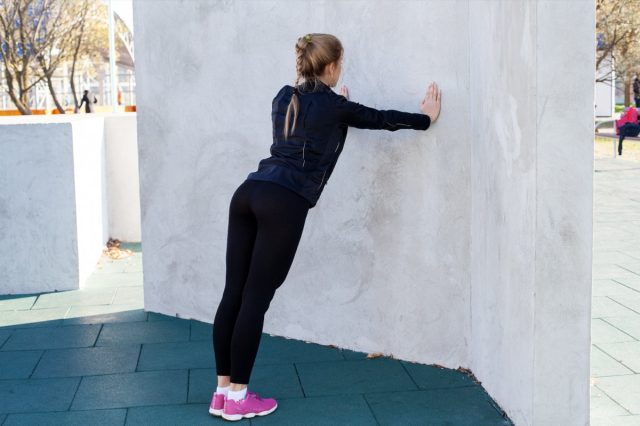
This builds pressing strength in your chest, shoulders, and triceps while training your core to stay rigid. More importantly, it teaches your body to move as one connected unit, which transfers directly to getting up from the floor or pushing yourself out of a chair.
How to do it:
- Stand arm’s length from a wall
- Place your hands flat against the wall slightly wider than shoulder-width, fingers pointing up
- Step back until your body forms a straight line from head to heels
- Keep your core tight – imagine someone’s about to punch you in the stomach
- Lower your chest to the wall by bending your elbows, keeping them at about a 45-degree angle from your body (not flared out to the sides)
- Your whole body should move as one piece
- Push back to the starting position
What NOT to do:
- Do not let your hips sag or pike up
- Do not shrug your shoulders up to your ears
- Do not let your elbows flare out at 90 degrees – this puts excessive strain on your shoulder joints
- Do not rush the movement – take 2 seconds down, 2 seconds up
- Quality beats speed every single time
Sit-to-Stands (90 seconds)
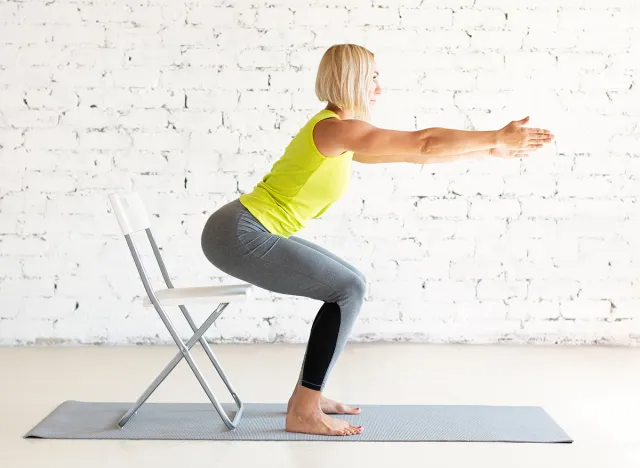
This is the single most functional exercise for maintaining independence. It builds strength in your quads, glutes, and core while directly training the exact movement you do dozens of times daily – getting in and out of chairs, on and off the toilet, out of your car.
How to do it:
- Stand in front of a sturdy chair (one that won’t slide)
- Your feet should be hip-width apart, toes pointing slightly outward
- Cross your arms over your chest (or hold them straight out in front for balance if needed)
- Push your hips back as if you’re reaching for the chair with your bum
- Lower yourself with control until you lightly touch the seat – don’t plop down
- Immediately stand back up by driving through your heels and squeezing your glutes at the top
What NOT to do:
- Do not let your knees cave inward – keep them tracking over your toes
- Do not lean forward excessively – your chest should stay relatively upright
- Do not drop onto the chair – that defeats the purpose
- Do not use your hands to push off the chair or your legs – this is a leg exercise, not an arm exercise
- Do not let your weight shift onto your toes – keep it in your heels and midfoot
Modified Plank Hold (90 seconds)
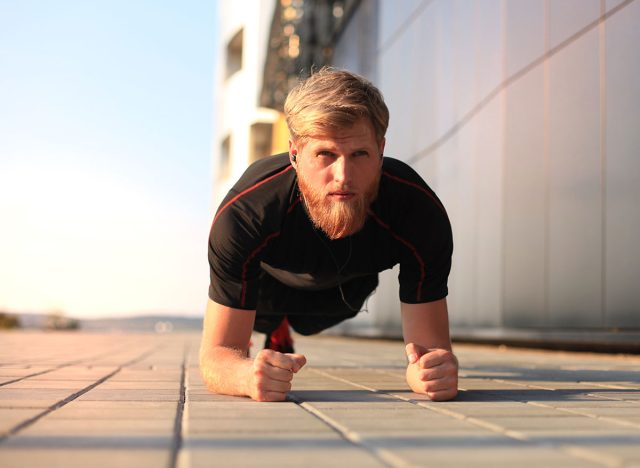
This builds serious core strength and teaches your entire body to work as one unit. A strong core isn’t about having visible abs – it’s about protecting your spine, improving your posture, and giving you a stable foundation for every movement you make.
How to do it:
- Get on your hands and knees
- Place your forearms on the ground, elbows directly under your shoulders
- Step your feet back until your body forms a straight line from head to heels (or keep your knees on the ground if full plank is too challenging – there’s no shame in that)
- Pull your belly button toward your spine
- Squeeze your glutes
- Don’t let your hips sag or pike up
- Hold this position while breathing normally
What NOT to do:
- Do not hold your breath – breathe steadily throughout
- Do not let your lower back sag downward – that’s asking for back pain
- Do not pike your hips up toward the ceiling – your body should be a straight line
- Do not let your shoulder blades wing out – keep them pulled together slightly
- Do not look up – keep your neck neutral by looking at the floor between your hands
Wall Angels (90 seconds)

This opens up your chest and shoulders, which get chronically tight from daily life (driving, computer work, phone use). It strengthens the muscles in your upper back that pull your shoulders back and improves your posture. Better posture means better breathing, less neck and shoulder pain, and you look more confident.
How to do it:
- Stand with your back against a wall, feet about 6 inches away from it
- Press your lower back, upper back, and head against the wall
- Raise your arms into a goal post position – elbows bent at 90 degrees, upper arms parallel to the floor
- Try to keep your elbows and the backs of your hands touching the wall (or as close as possible)
- Slowly slide your arms up the wall as high as you can while keeping everything in contact
- Lower back down with control
What NOT to do:
- Do not arch your lower back off the wall as your arms go up – keep it pressed against the wall
- Do not let your head come forward – keep the back of your skull on the wall
- Do not force your hands flat if they won’t go – it’s more important to keep your back and head positioned correctly
- Do not shrug your shoulders toward your ears
- Do not go so high that you lose the position – only go as far as you can while maintaining contact points
Heel Raises (90 seconds)
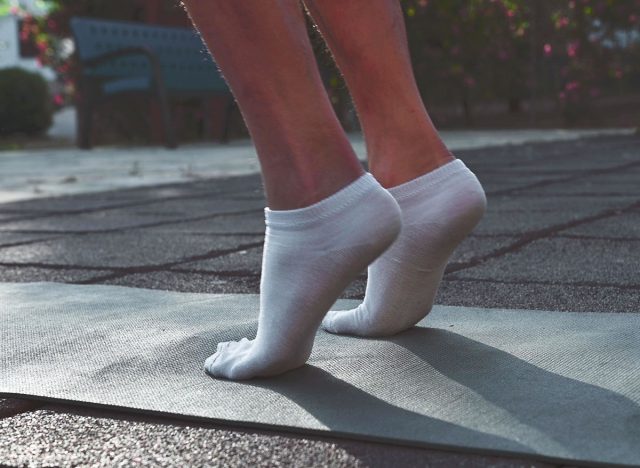
This strengthens your calves and, more importantly, your ankle stability. Strong, stable ankles are critical for preventing trips and falls. They’re also what let you walk on uneven surfaces confidently – something most people start avoiding as they age because their ankles feel unstable.
How to do it:
- Stand facing a wall or counter with your fingertips lightly touching it for balance
- Feet hip-width apart, toes pointing forward
- Rise up onto the balls of your feet, lifting your heels as high as possible
- Pause at the top for a second
- Lower back down with control
- You should feel this working in your calves
What NOT to do:
- Do not bounce at the bottom – each rep should be smooth and controlled
- Do not let your ankles wobble or roll outward – keep them stable and vertical
- Do not lean forward onto the wall – it’s there for balance only
- Do not rush through these – take 2 seconds up, hold for 1, take 2 seconds down
- Do not lift your toes off the ground at the top
Standing Core Rotations (90 seconds)
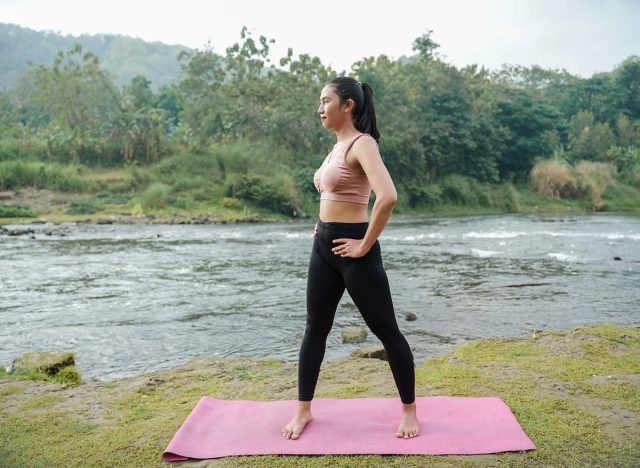
This builds rotational core strength, which is missing from most exercise routines but critical for daily life. Every time you reach for something, get out of a car, look over your shoulder while driving, or carry shopping bags, you’re using rotational strength. This exercise also improves your balance by challenging your body to stay stable while rotating.
How to do it:
- Stand with feet hip-width apart, knees slightly bent
- Clasp your hands together in front of your chest, elbows bent
- Keep your hips facing forward (they shouldn’t rotate)
- Rotate your upper body to the right as far as comfortable, then return to center
- Rotate to the left, return to center
- That’s one rep
- Your hips and legs should stay still – all rotation comes from your torso
What NOT to do:
- Do not let your hips rotate with your torso – they should face forward the entire time
- Do not hold your breath – breathe naturally throughout
- Do not jerk or twist violently – smooth, controlled movements only
- Do not lean to the side as you rotate – stay upright
- Do not let your arms drift away from your chest – they should move with your torso as one unit
How to Structure Your 8-Minute Workout
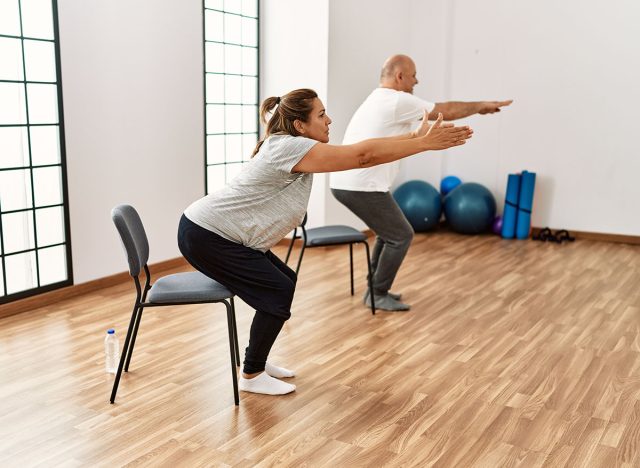
Do each exercise for 90 seconds, moving from one straight to the next with no rest between exercises. Yes, this means you’re moving continuously for the full 8 minutes.
Within each 90-second block, work at your own pace. If you need to pause for 5-10 seconds during an exercise, that’s completely fine – especially in the first couple of weeks. As you get stronger, you’ll be able to maintain steady movement for the entire 90 seconds.
For the first week, focus on learning the movements correctly. Count your reps so you have a baseline – maybe you do 12 wall push-ups in 90 seconds the first day. That’s your starting point. Next week, aim for 13. The week after, 14. Gradual progression like this adds up quickly.
Do this routine six days a week. Take one day completely off. Your body needs that recovery day to adapt and get stronger.
What Results You Can Expect in 30 Days

In 30 days, the changes are mostly neurological and functional. You won’t look dramatically different in the mirror, but you’ll feel dramatically different in how you move. Getting out of chairs becomes noticeably easier. Stairs don’t wind you as much. Your balance feels more confident. You’ll probably be able to do 40-50% more reps of each exercise than when you started. This isn’t because you’ve built loads of muscle: it’s because your nervous system has become far more efficient at recruiting muscle fibers and coordinating movement.
Your posture improves within the first month. People often report less shoulder and neck tension. You’ll probably notice you’re standing taller without thinking about it. Energy levels usually increase – not in a dramatic, caffeine-like way, but you’ll notice you’re less fatigued by normal daily activities.
Sleep often improves. Regular movement, even just 8 minutes daily, has a measurable effect on sleep quality. You’ll likely fall asleep faster and wake up less during the night. This isn’t directly related to strength, but it’s one of the most commonly reported benefits in the first month.
What Results You Can Expect in 60 Days

At 60 days, you’ll start seeing visible changes. Your legs and arms will look slightly more defined. Not bulging muscles, but you’ll notice more shape and firmness. If you’re carrying extra weight, you might notice clothes fitting slightly better, though this routine alone won’t create significant fat loss – that requires addressing nutrition as well.
Functionally, the changes become more pronounced. Activities you were avoiding become manageable again. Maybe you start taking stairs instead of lifts. You stop hesitating before getting up from low chairs. You can reach into high cupboards without wobbling. These sound like small things, but they’re markers of genuine strength improvement and better balance.
Your reps will likely have doubled or more from where you started. If you did 10 wall push-ups in 90 seconds on day one, you might be doing 20-25 by day 60. This progression is real strength gain – your muscles are producing more force, and your endurance within that movement pattern has increased substantially.
Confidence is perhaps the biggest change. Most people over 50 start to feel physically uncertain – they second-guess their movements, they worry about falling, they avoid physical challenges. Two months of consistent training rebuilds that confidence. You start trusting your body again because it’s demonstrating reliability every single day.
The most important result is the habit. By 60 days, this routine has become part of your life. You don’t debate whether to do it, you just do it, the same way you make coffee in the morning. That habit is worth more than any temporary physical change because it’s what keeps you strong for years to come.